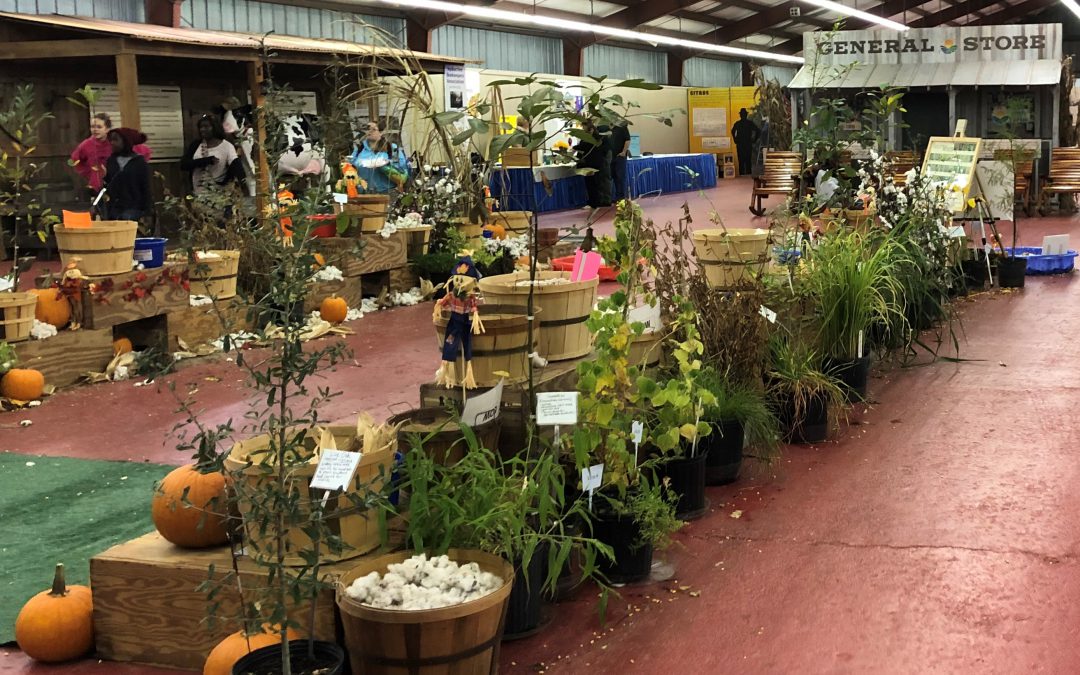
by Molly Jameson | Nov 7, 2019
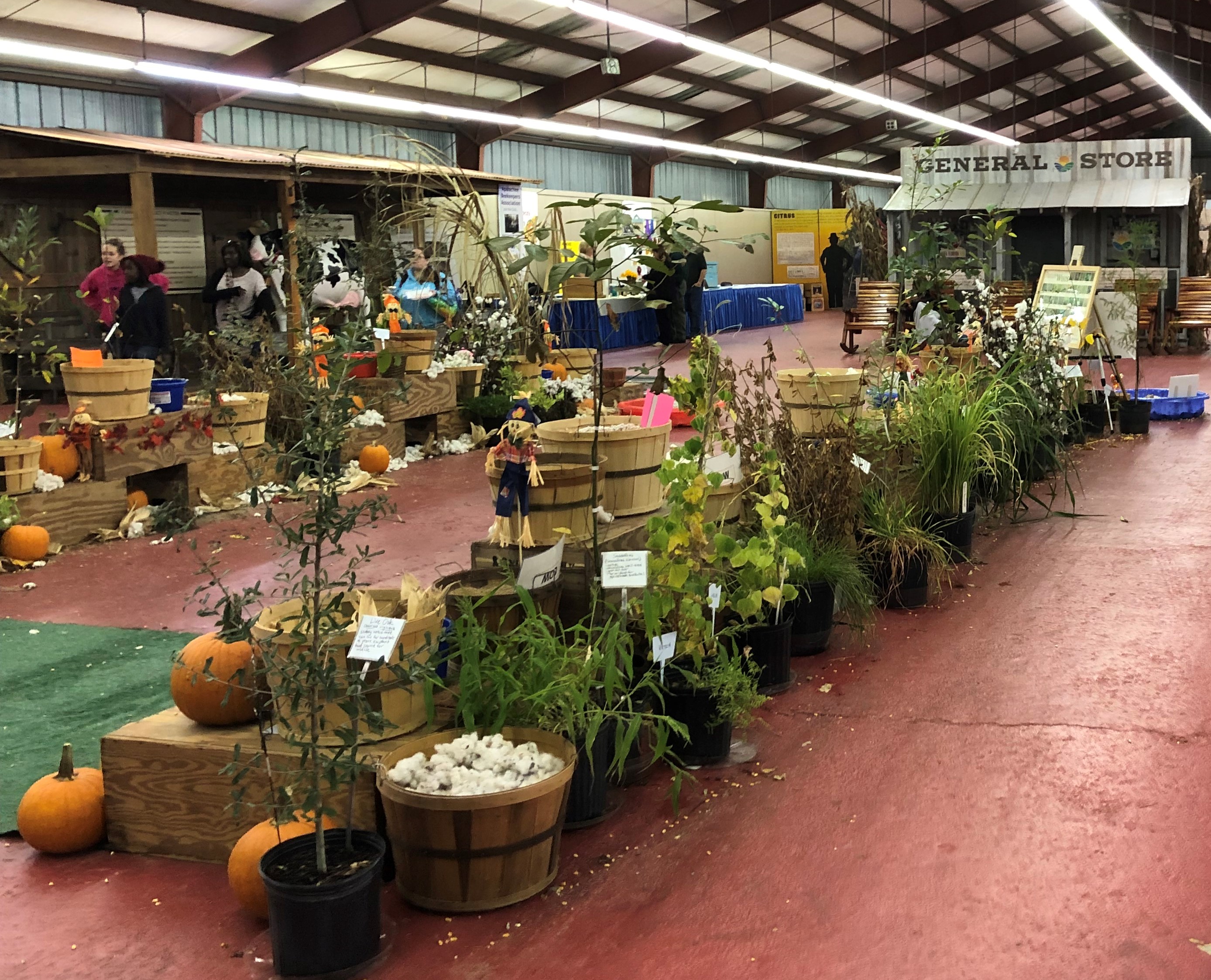
There are hands-on agricultural crop displays and much more in the UF/IFAS building at the North Florida Fair. Photo by Molly Jameson.
New Demonstrations in the UF/IFAS Extension Building at the North Florida Fair
Every year during the North Florida Fair in Tallahassee, extension agents from all over the Florida Panhandle showcase their various programming in the UF/IFAS exhibitor building. This includes educational displays and hands-on activities in areas such as horticulture, agriculture, livestock, 4-H youth, natural resources, and family and consumer sciences.

Once you have your fill of fair rides and funnel cake, see a live educational demonstration at the UF/IFAS building! Photo by Molly Jameson.
For instance, visitors can view and touch agricultural crops grown in our area, play in a giant tub of actual cotton, match images of song birds with their names, make a 4-H craft, and learn about the importance of wildlife habitat for animals.
This year, Extension is including even more to do and learn in the UF/IFAS building. There will be live demonstrations taking place throughout the fair week, which is November 7 to 17 this year.
Did you know you can convert recycled containers, such as milk jugs and soda bottles into self-watering planters? Or that when saltwater reef fishing, if fish are brought to the surface too quickly, it can rupture their organs? Learn all about these concepts and more during the UF/IFAS Extension Live Demonstrations.
UF/IFAS Live Demonstration Schedule:
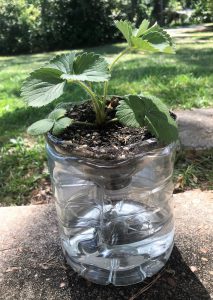
Turn all types of containers into self-watering gardens, such as planting a strawberry in a plastic jug using strips of old cloth as a wick. Photo by John Edwards.
Saturday, November 9:
- 1:00 p.m. – Food Safety with Extension Agent Kendra Zamojski
- 2:00 p.m. – Avoiding Barotrauma while Deep Sea Fishing with Extension Agent Andrea Albertin
Monday, November 11:
- 1:00 p.m. & 4:00 p.m. – Reef Fish Catch and Release Techniques with Extension Agent Laura Tiu
Tuesday, November 12:
- 6:30 p.m. – Rose Propagation with Extension Agent Matt Orwat
Thursday, November 14:
- 6:15 p.m. – Starting Plants in Recycled Newspaper with Extension Agent Paula Davis
- 7:00 p.m. – Food Safety with Extension Agents Laurie Osgood and Amy Mullins
Saturday, November 16:
- 3:00 p.m. – Planting with Recycled Containers with Extension Agents Molly Jameson, Mark Tancig, and Allison Leo
Sunday, November 17:
- 7:00 p.m. & 8:00 p.m. – Reef Fish Catch and Release Techniques with Extension Agent Erik Lovestrand
For more information about the North Florida Fair, visit the website at http://northfloridafair.com/.
See you at the fair!
by Molly Jameson | Sep 16, 2019

2019 Panhandle Fruit and Vegetable Conference: Seeking to Bridge the Agricultural Gap
Join UF/IFAS Extension on October 2 and 3 for the 2019 Panhandle Fruit and Vegetable Conference. Not only will participants get the opportunity to learn about some of the most current innovations in fruit, nut, and vegetable production; marketing and business; and alternative enterprises in the southeast; they will also have the pleasure of hearing the keynote address from Dr. Cary Rivard, an Associate Professor, Extension Specialist, and Director of the Kansas State Research and Extension Center.

The 2019 Panhandle Fruit and Vegetable Conference keynote speaker is Dr. Cary Rivard, an Associate Professor, Extension Specialist, and Director of the Kansas State Research and Extension Center.
Dr. Cary Rivard knows the horticultural and agricultural industries well, as he grew up helping his parents operate a greenhouse business in Kansas City, Missouri. Embracing his family roots, he received his Bachelor of Science degree in agricultural science and biology from Truman State University and his Master of Science and doctorate degrees in plant pathology from North Carolina State University.
But Dr. Rivard knows not everyone gets to grow up witnessing the importance of the agricultural industry firsthand, nor does everyone study agricultural sciences in pursuit of educational degrees. Therefore, throughout Dr. Rivard’s career, he has sought projects that work to connect urban communities with agriculture. As we all know, technological innovations in the 21st century have connected communities in more ways than we could have ever imagined. Yet, it seems a disconnect has arisen among the people in these communities and the food they eat and the farmers who grow that food. But Dr. Rivard sees this disconnect as opportunity. He knows it is agricultural and horticultural leaders – both university specialists and farmers – who can bridge the gap between urban communities and the agricultural products on which they, knowingly or unknowingly, truly rely.
At the Panhandle Fruit and Vegetable Conference, Dr. Rivard will discuss his mission to connect urban communities and agriculture, including his work coordinating the Growing Growers Kansas City program, which provides education to new and experienced growers through farm apprenticeships and an annual workshop series. In addition to speaking as the 2019 Panhandle Fruit and Vegetable Conference keynote speaker, Dr. Rivard will also present one of the conference sessions, where he will discuss his effort to integrate crop diversity and crop rotations into high tunnel production systems.
Register to attend the UF/IFAS Extension 2019 Panhandle Fruit and Vegetable Conference and Post-Conference Tour on Eventbrite (https://panhandlefv2019.eventbrite.com). The main conference will be held on October 2 at the Emerald Coast Convention Center in Fort Walton Beach, Florida. The post-conference tour on October 3 will be a great chance to chat with farmers, and it kicks-off with breakfast at the Emerald Coast Convention Center. Participants will then ride together by bus to tour local farms, enjoy lunch, and be returned to the Convention Center by 3 p.m.
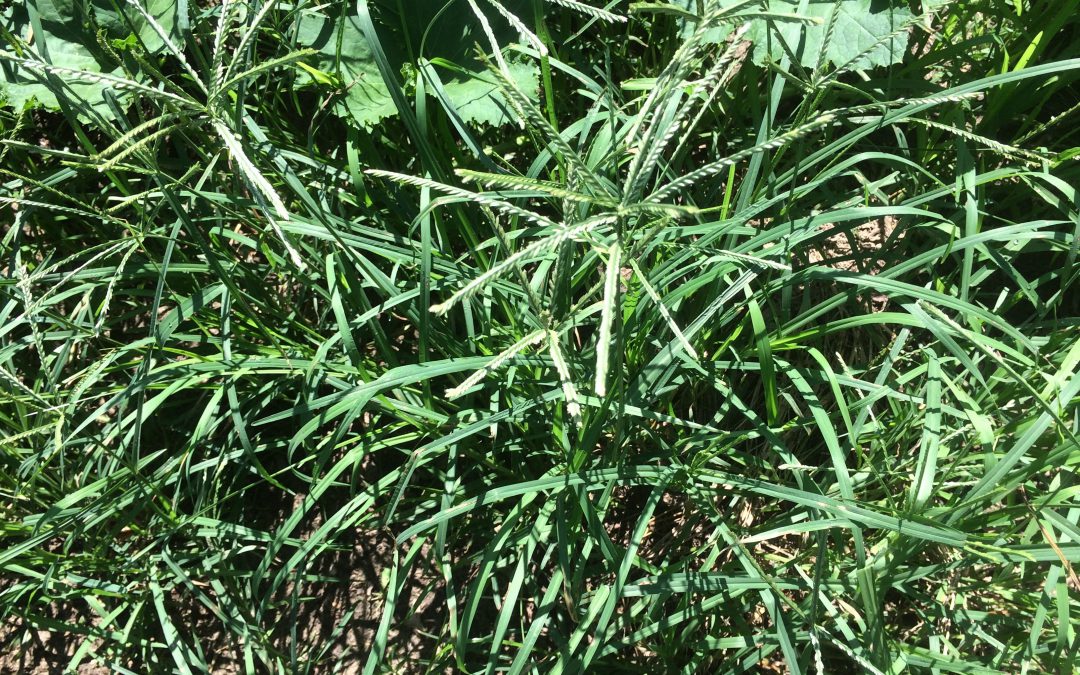
by Molly Jameson | Aug 28, 2019
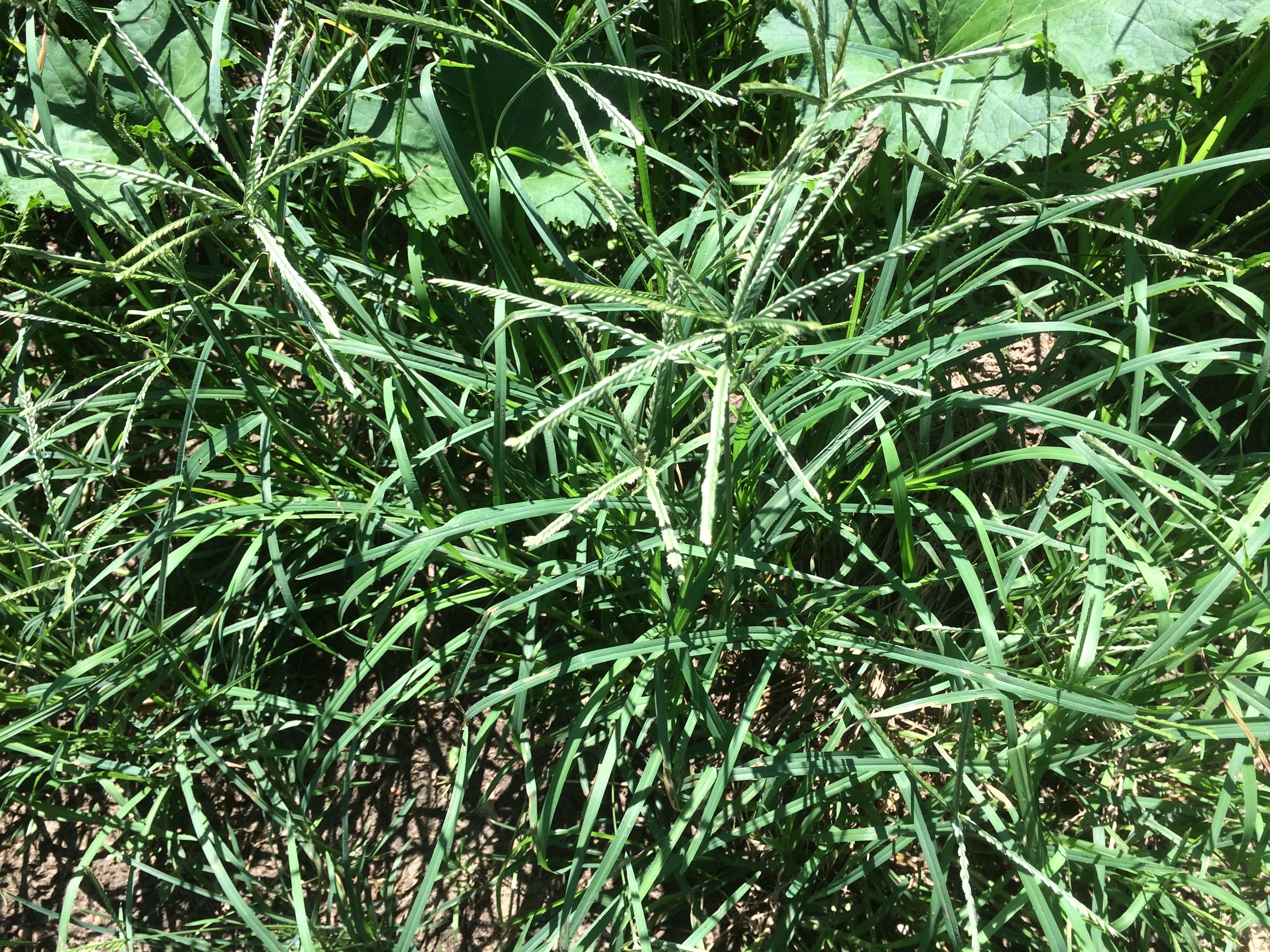
Vaseygrass produces prolific seed heads, and once introduced, can be spread easily by farming equipment. Photo by Herman Holley.
Beware Vaseygrass, an Aggressive Exotic Weed
A couple months ago I got a concerning call from a local small farmer. Rich Pouncey, of Bumpy Road Farm in northern Leon County, was very troubled by an unwelcome visitor he found growing on his farm.
Rich, who grows multiple crops, including heirloom corn varieties to create his delicious cornmeal and grits, noticed something amok in a portion of his rows. With closer inspection – and a visit from Extension Agent Les Harrison – it was identified as vaseygrass (Paspalum urvillei). Vaseygrass, an aggressive exotic species from South America, was starting to take complete control of a large section of Rich’s small growing space he had reserved for upcoming collard production.
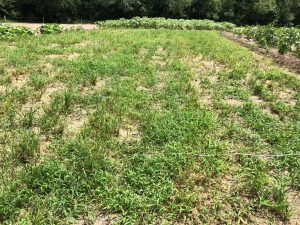
With its abundant seed heads and our consistent summer rainstorms, vaseygrass quickly took over a section of Rich’s field. Photo by Molly Jameson.
Rich, who prides himself on supporting biological diversity, soil health, and native pollinators, uses strictly organic growing methods in raising his crops. Therefore, the presence of such an aggressive exotic was truly of grave concern.
Rich is not sure exactly how this weed was introduced to his fields. He suspects it may have been hidden in a soil amendment he purchased, but he cannot be certain of the source. It is certainly a reminder to be careful when bringing in outside equipment, mulch, and any new agricultural products.
When mature, vaseygrass can grow to six-feet tall with plentiful seed heads, and it flourishes in warm, wet conditions. It spreads by seeds and has very high rates of germination during times of abundant rainfall. The grass is low in nutrition – making it a poor choice for grazing cattle – but in a hay field, it will spread like wildfire if not controlled.
Vaseygrass is a true perennial bunch grass, with a small root system and, fortunately, few rhizomes. Rich began pulling and black bagging as much of the grass as he could each day, but struggled to keep up, and it quickly spread through more than a tenth of an acre of his field.
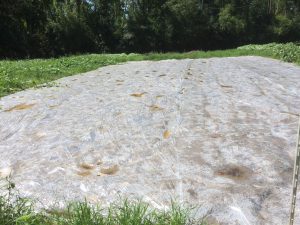
When hand pulling wasn’t enough, Rich switched to solarization, hoping to kill emerged vaseygrass seedlings and seeds with heat. Photo by Herman Holley.
About six weeks ago, Rich changed strategies and began solarizing the area with clear plastic sheeting. Tightly covering soil with clear plastic sheeting in the warmest summer months can trap heat and increase temperatures, potentially killing weeds, pests, and diseases within the top foot of the soil surface. He will find out soon if this control strategy has been successful, as he’ll be pulling up the plastic in September. He knows that if the solarization is not successful, he may have no choice but to use chemical control methods, which will mean he will have to wait years to grow any crops in this area he wishes to market as organically grown.
If hand pulling isn’t enough, small infestations of vaseygrass can be controlled by spot spraying a one percent glyphosate solution at 1.2 ounces/gallon. Be aware, mowing and tilling can make the problem worse, as the scattering and burying of seeds can exacerbate the infestation.
For more details about identifying and controlling vaseygrass, read the UF/IFAS EDIS publication, Identification and Control of Johnsongrass, Vaseygrass, and Guinea Grass in Pastures (https://edis.ifas.ufl.edu/ag372).
If you suspect vaseygrass is growing on your property, contact your local county extension agent to get the grass properly identified and help spread the word about its presence.
by Molly Jameson | Aug 7, 2019

Rachel Mathes, Leon County Horticulture Program Assistant
Article by Rachel Mathes, Leon County Horticulture Program Assistant
Sensory gardens are a great way to involve children and people with special needs with gardening. Gardens provide a no-judgement zone for creative expression and allow us to get down in the dirt every now and then. Because sensory gardens are designed to be appreciated by more than just the sense of sight, they are an approachable way for disabled and non-disabled users alike. By engaging taste, feel, smell, hearing, and more, sensory gardens allow visitors of all ages and circumstances to engage in gardening.
To make your own sensory garden, think about what feeling you would like to experience while visiting your garden. Do you want a calm healing place of introspection or perhaps a vibrant playful area for engaged learning in nature? Having a theme can help you choose the different elements you would like to include in your sensory garden, which can be an entire yard or as small as a container. They are being used more and more in memory care units of nursing homes as well as preschools and elementary schools, but you can make your own right at home.

Water features provide enticing sounds for human visitors and a water source for wildlife. Can you spot the honeybee enjoying the fountain? Photo by Rachel Mathes.
The sound of moving water is calming to many, so a small fountain can be a great addition to your sensory garden. It will also benefit local wildlife by offering them a small watering hole. As long as the water is moving, mosquitos should not be a problem, but mosquito dunks or even the incorporation of mosquito fish are easy solutions to solving mosquito problems in small ponds or fountains. Some plants to consider for their sounds include false indigo (Baptisia australis), switchgrass (Panicum virgatum), and mountain oats (Chasmanthium latifolium). False indigo produces seed pods great for rattling, and when it is windy, switchgrass and mountain oats provide a gentle rustle.
A variety of textures offers the gardener a safe place to interact with nature without worrying about the dangers of poison ivy and other plant irritants. Plants like muhly grass (Muhlenbergia capillaris) offer a multitude of interactions as they sway in the wind, have bright white and pink blooms, and can be braided together in a variety of patterns. The native sunshine mimosa (Mimosa strigillosa) is a low growing ground cover that puts out pink powderpuff flowers and folds up when touched. Some other plants to explore by touch are lamb’s ear (Stachys byzantine), maiden grass (Miscanthus sinensis), the mildly dangerous points of aloe, and the many textures of southern magnolia (Magnolia grandiflora).
There are plenty of smelly plants to entice your nose in the garden. From rosemary to dill, mint and beyond, many herbs do very well here in the Florida Panhandle. Lemon balm and lemongrass bring a punch of citrus without the need for a big citrus tree. Beyond herbs, pine needles give a resinous scent when compressed, gardenias offer heavy sweetness from their voluminous white blooms, and sweet almond verbena (Aloysia virgata) delights with a vanilla almond aroma that carries pleasantly in the wind.

Fragrant blooms can offer pleasant aromas to enhance a sensory garden. Photo by Rachel Mathes.
When it comes to tasting in a sensory garden, fruits and vegetables are an obvious choice. Plenty of annual vegetables can be grown year-round, from leafy greens in the fall, winter, and early spring, to tomatoes and peppers in the summer. Blackberries are an easy to grow favorite in this part of the state, are available as thornless varieties, and take well to growing on a trellis in small spaces. A great edible that many children favor in the Demonstration Garden at the Leon County Extension Office is cranberry hibiscus. The bright red leaves of new growth are a sweet and sour treat they equate to Sour Patch Kids candy. The older leaves can be added into stir fries and salads and the flowers can be cooked into a syrup for making purple lemonade. Herbs can be used for their taste factor as well. But if your sensory garden will be visited by the general public without supervision, I recommend clear delineation for the tasting area so that no one eats anything unpalatable or poisonous by accident.
When setting up your sensory garden, be sure to involve your intended audience. Small children thrive when given a job to do and will enjoy planting sweet herbs alongside you. Even regular maintenance of the garden can involve the participants you hope to engage. The simple acts of weeding and watering can foster a sense of responsibility and empowerment as the visitors gain sensory enrichment through these activities and see the fruits of their labor with time.
 Rachel Mathes is the Horticulture Program Assistant for UF/IFAS Extension Leon County.
Rachel Mathes is the Horticulture Program Assistant for UF/IFAS Extension Leon County.

by Molly Jameson | Jun 25, 2019
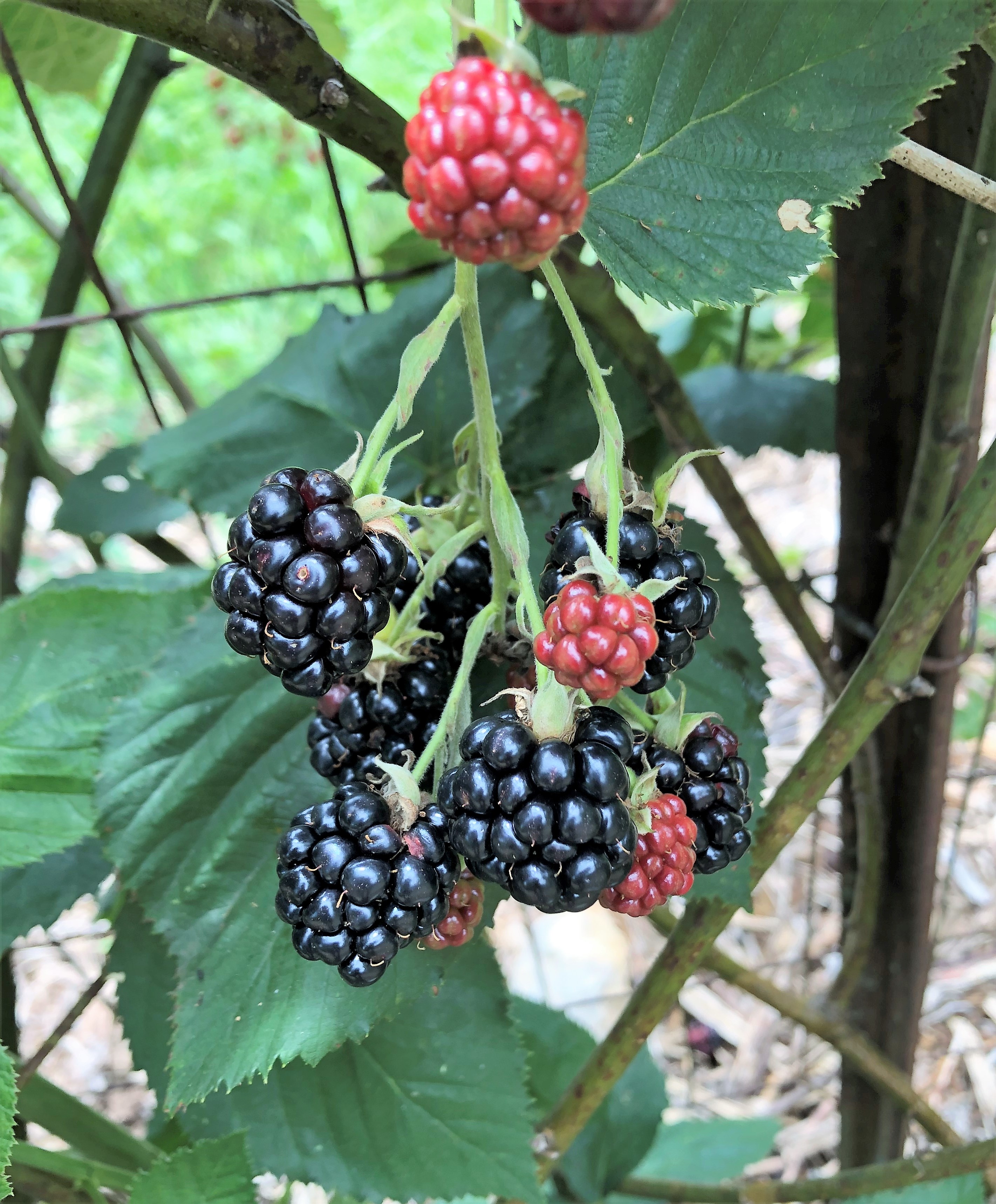
Although blackberries are well adapted to North Florida, many different biotic and abiotic factors can impact fruit production. Photo by Molly Jameson.
Diagnosing Abiotic Blackberry Fruit Disorders
Whether it be wild blackberries you’ve foraged or a prized cultured variety you’ve oh-so-carefully sustained, we are now in prime blackberry season, and there are many sweet, tangy delectable fruits to be eaten.
Blackberry bushes are well adapted to the Florida Panhandle and the plants can be found growing all over – along roadways, in ditches, throughout open fields, and also within forests.
Although wild blackberries and domesticated cultivars thrive in our climate, there is a wide range of factors that could affect blackberry fruiting. When diagnosing plant problems, we tend to blame insects and diseases, but there are many abiotic (non-living) factors that could negatively impact blackberry fruit production. If your blackberry drupelets (the small subdivisions that comprise a blackberry fruit) are compromised, you may be experiencing one or more of the following abiotic blackberry disorders.
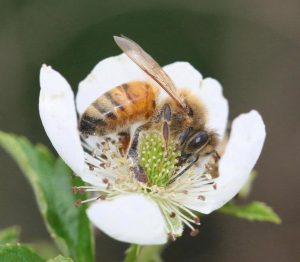
Although blackberries can self-pollinate, insect pollination is critical for forming the best blackberries. Photo by Johnny N. Dell, Bugwood.org.
Poor Pollination. Blackberries, strangely enough, are not true berries botanically. True berries only have one ovary per flower (such as bananas, watermelons, and avocados!). Each blackberry flower contains over 100 female flower parts, called pistils, that contain ovaries. To form a fully sized blackberry with many drupelets, at least 75% of the ovaries need to be pollinated. While blackberries can self-pollinate, pollinator insects, such as bees, are very important to ensure adequate drupelet formation. When weather conditions are overly cloudy and rainy, bees are less active. If this coincides with blackberry flowering, you may end up with some blackberries that are nearly drupe-less.
White Drupe. If you notice patches of white and brown drupelets on your most sun-exposed canes, you might have white drupe disorder. When humidity drops and temperature heats up, solar radiation contacting your berries is more powerful, as there is less moisture in the air to deflect the intense heat. Berries that are not protected by leaf coverage, and those on trellises oriented for maximum sun exposure, are most vulnerable to white drupe damage.
Sunscald. Often associated with white drupe, sunscald is most common when temperatures are extreme. Daytime highs in the Florida Panhandle in June and July regularly reach 90°F, if not higher. At these times, fruit exposed to the sun can be hotter than the air temperature around them, which essentially cooks the fruit. As I suspect you’d prefer to cook your fruit after harvest in preparation for blackberry pie, orient your trellis so it gets shade relief during the hottest part of the day and harvest often.

Diagnosing a blackberry issue can be challenging, as there can be more than one culprit impacting the fruit. Photo by Molly Jameson.
Red Cell Regression. One of the not-so-well understood abiotic blackberry disorders is red cell regression, or red drupelet disorder. If you’ve ever harvested blackberry fruit and stored them in the refrigerator for later munching, you may think your eyes are deceiving you when you discover your fruit doesn’t appear as ripe as when you picked it. This regression in color is linked to rapid temperature change, but rest assured, it does not affect the sugar content of the fruit. There are a few things you can do if you think this is affecting your berries, such as harvesting in the morning when the berries are still cool, harvesting when the sky is overcast, or shading your berries pre-harvest. You can also try to cool your berries in stages, perhaps moving from the field, to shade, to A/C, and then to the fridge.
Beyond abiotic stresses, blackberries can also suffer from insect, pest, and disease damage, such as from stink bugs, beetles, mites, birds, anthracnose, leaf rust, crown gall, and beyond. For domesticated blueberry bushes, proper cultivar selection, site selection, planting technique, fertilization, irrigation, propagation, and cane training is important and will allow the plants to grow healthy to defend themselves against any abiotic or biotic nuisance that comes their way.
For more information about growing blackberries, check out the EDIS publication, The Blackberry (https://edis.ifas.ufl.edu/hs104).

















